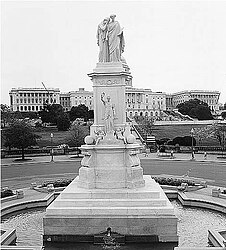Peace Monument
| Navy - Peace Monument | ||
|---|---|---|
| National Register of Historic Places | ||
| Historic District | ||
| Historic District Contributing Property | ||
|
Peace Monument, 2011 |
||
|
|
||
| location | Traffic island at the intersection of 1st Ave., NW and Pennsylvania Ave., NW, Washington, DC , USA | |
| Coordinates | ||
| Built | 1877 | |
| architect | Edward Clark (architect), Franklin Simmons (sculptor) | |
| Architectural style | classicism | |
| NRHP number | 78000257 | |
| The NRHP added | 20th September 1978 | |
The Peace Monument (dt. Peace Memorial ), also known as Naval Monument or Civil War Sailors Monument known stands on the site of the United States Capitol in Peace Circle, a roundabout, the First Street, NW, and Pennsylvania Avenue in Washington, DC connects.
The 13.4 meter high monument made of white marble was erected in 1877/1878 in memory of the members of the Navy who died in the Civil War . Today it is part of a three-part monument group, which also includes the James A. Garfield Monument and the Ulysses S. Grant Memorial .
At the top of the west-facing monument stand two female, classically dressed figures. The grief lays her face covered with her hand on the shoulder of the story and weeps bitterly. The story holds a pen and a blackboard on which the inscription "They died that their country might live." Can be read. Below the grief and story is another classic female figure, the Victora . She holds a laurel wreath in the air and an oak branch in the other hand, this stands for severity. Under the Victoria are the child Mars , god of war, and child Neptune , god of the sea. The hull of the monument is decorated with wreaths, ribbons and scallops .
Facing the Capitol is the goddess Peace , who is holding an olive branch. Below it are the symbols for peace and diligence. Opposite symbols for science, literature and art (compass, book, cogwheel and angle) show that peace made the progress of civilization possible.
At the corners of the monument, four marble balls are visually supported by massive brackets. In the well below, the water runs through a pipe on each side into the four-pass basin. The inscription reads "In memory of the officers, sailors and marines of the United States Navy who died defending the Union and the freedom of their country, 1861-1865".
The sculptor for the memorial was Franklin Simmons (1839–1913), born in Maine , where he was best known for his portrait busts. He lived since 1868 in Rome , when he was commissioned a statue of Roger Williams for the National Statuary Hall - collection to create. In total, he made four statues and three busts for the Capitol. The Peace Monument is an example of his idealized neoclassical sculptures.
The Peace Monument, first planned for Annapolis (Maryland) , was designed by Admiral David Dixon Porter . He had commanded the fleets of gunboats and troop transports during the war. Porter had first created a simple design that represented sadness and history. In 1865 he began to raise funds from private donors; In 1871 he commissioned the monument. The sculptor worked on the Carrara marble in Rome and also worked directly with Admiral Porter on many changes to the designs, including the addition of more figures. The architectural part of the monument was taken over by the Bonanni brothers from Carrara under the direction of Simmons . The marble pieces were shipped to Washington in 1876. 1877, the monument was on a pedestal made of blue granite erected from Main, from the Architect of the Capitol , Edward Clark was designed. Finally, the last figure, Peace, was added in January 1878.
Web links
- Architect of the Capitol Website: Peace Monument
Coordinates: 38 ° 53 '26.3 " N , 77 ° 0' 44.4" W.

